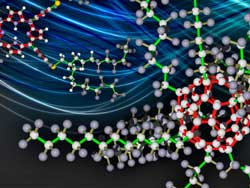The 'molecular octopus': A little brother of 'Schroedinger’s cat'

Artistic view of the most complex and massive molecules (PFNS-10, TPP-152) brought to quantum interference (Illustration: Mathias Tomandl) <br>
The international and interdisciplinary team of scientists thus sets a new record in the verification of the quantum properties of nanoparticles. In addition, an important aspect of the famous thought experiment known as 'Schroedinger’s cat' is probed. However, due to the particular shape of the chosen molecules the reported experiment could be more fittingly called 'molecular octopus'.
'Schroedinger's cat': simultaneously dead and alive?
Since the beginning of the 20th century, quantum mechanics has been a pillar of modern physics. Still, some of its predictions seem to disagree with our common sense and the observations in our everyday life. This contradiction was brought to the fore 80 years ago by the Austrian physicist Erwin Schroedinger; he wondered whether it was possible to realize states of extreme superposition such as, for example, that of a cat which is simultaneously dead and alive. This experiment has not been realized with actual cats for good reasons. Nevertheless, the successful experiments by Gerlich et al. show that it is possible to reproduce important aspects of this thought experiment with large organic molecules.
'Superposition' demonstrated for larger and larger molecules
In quantum physics, the propagation of massive particles is described by means of matter waves. In a certain sense, this means that the particles loose their classical property of a well-defined position and their quantum wave function can extend simultaneously over a large area. Formally, this state resembles that of a cat that is at the same time dead and alive. In quantum physics this is called a 'superposition'.
Markus Arndt and his team at the University of Vienna tackle the question, up to which degree of complexity the amazing laws of quantum physics still apply. To this end, they investigate the quantum behaviour of molecules of increasing size, in particular their superposition at various positions in an interferometer. The high instability of most organic complexes, however, poses a major challenge in the process.
Tailor-made molecules solve the problem of instability
Many molecules break apart during the preparation of the thermal particle beam. Therefore, a close collaboration with chemists from Switzerland and the United States was crucial for the success of the recent experiments. The team of Marcel Mayor at the University of Basel and Paul J. Fagan from Central Research and Development of DuPont in Wilmington, DE, accomplished the synthesis of massive molecule complexes, which can survive the critical evaporation process.
A new record
The use of specifically synthesized organic molecules consisting of complexes of up to 430 atoms enabled the researchers to demonstrate the quantum wave nature in mass and size regimes that hitherto had been experimentally inaccessible. These particles are comparable in size, mass and complexity to Insulin molecules and exhibit many features of classical objects. Nevertheless, in the current experiment the tailor-made molecules can exist in a superposition of clearly distinguishable positions and therefore – similar to 'Schroedinger’s cat' – in a state that is excluded in classical physics.
Publication
Quantum interference of large organic molecules: Stefan Gerlich, Sandra Eibenberger, Mathias Tomandl, Stefan Nimmrichter, Klaus Hornberger, Paul J. Fagan, Jens Tüxen, Marcel Mayor and Markus Arndt.
In: Nature Communications, April 5, 2011, doi: 10.1038/ncomms1263
Full text: http://www.nature.com/ncomms/journal/v2/n4/full/ncomms1263.html
Scientific Contact
Univ.-Prof. Dr. Markus Arndt
Group Speaker of the Quantum Optics, Quantum Nanophysics and Quantum Information
University of Vienna
1090 Vienna, Boltzmanngasse 5
T +43-1-4277-512 05
markus.arndt@univie.ac.at
www.quantumnano.at
Queries
Mag. Petra Beckmannova
Quantum Optics, Quantum Nanophysics and Quantum Information
University of Vienna
1090 Vienna, Boltzmanngasse 5
T +43-1-4277-512 05
quantum-office@univie.ac.at
Media Contact
More Information:
http://www.univie.ac.atAll latest news from the category: Physics and Astronomy
This area deals with the fundamental laws and building blocks of nature and how they interact, the properties and the behavior of matter, and research into space and time and their structures.
innovations-report provides in-depth reports and articles on subjects such as astrophysics, laser technologies, nuclear, quantum, particle and solid-state physics, nanotechnologies, planetary research and findings (Mars, Venus) and developments related to the Hubble Telescope.
Newest articles

High-energy-density aqueous battery based on halogen multi-electron transfer
Traditional non-aqueous lithium-ion batteries have a high energy density, but their safety is compromised due to the flammable organic electrolytes they utilize. Aqueous batteries use water as the solvent for…

First-ever combined heart pump and pig kidney transplant
…gives new hope to patient with terminal illness. Surgeons at NYU Langone Health performed the first-ever combined mechanical heart pump and gene-edited pig kidney transplant surgery in a 54-year-old woman…

Biophysics: Testing how well biomarkers work
LMU researchers have developed a method to determine how reliably target proteins can be labeled using super-resolution fluorescence microscopy. Modern microscopy techniques make it possible to examine the inner workings…





















